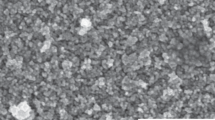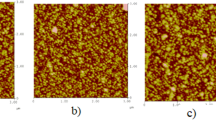Abstract
The results of the formation of an original material based on thin films of metal nanoclusters and the investigation of its chemical composition, surface morphology, and structure are presented. Monodisperse thin films comprised of individual nanoclusters of Ta, Mo, and Ni metals were manufactured by gas-phase magnetron sputtering. Images of the surface were obtained by scanning electron microscopy and it was shown that the Ta and Mo films had a well-developed porous structure and consisted of separate nanoclusters contacting each other only at the interface. The chemical composition of the resulting films immediately after deposition (in situ) and after exposure to the atmosphere (ex situ) was investigated by X-ray photoelectron spectroscopy. It was shown that the exposure to the atmosphere led to the oxidation of the obtained films, namely, to the formation of oxide shells in nanoclusters that formed the films. The possibility of creating thin-film photodetectors based on nanocluster films to detect the decay of isomeric nuclear transition in 229Th nuclei is discussed.




Similar content being viewed by others
REFERENCES
M.-J. Lee and E. Charbon, Jpn. J. Appl. Phys. 57, 1002A3 (2018).
P. V. Borisyuk et al., Eur. J. Mass Spectrom. 23, 146 (2017).
P. V. Borisyuk et al., arXiv:1804.00299 (2018).
K. N. Kwok, Complete Guide to Semiconductor Devices (Wiley-International, New York, 2002).
F. Ruffino et al., Nanoscale Res. Lett 3, 454 (2008).
K. Kukli et al., Thin Solid Films 260, 135 (1995).
X. Liu et al., J. Alloys Compd. 509, 408 (2011).
A. Krier et al., Phys. Status Solidi Appl. Mater. Sci. 205, 129 (2008).
D. Gall, J. Appl. Phys. 119, 085101 (2016).
D. Briggs and J. Grant, Surface Analysis by Auger and X-Ray Photoelectron Spectroscopy (IM Publ., Chichester, 2003).
J. Scofield, J. Electron Spectrosc. Relat. Phenom. 8, 129 (1976).
S. D’Addato and M. C. Spadaro, Phys. Scr. 93, 033001 (2018).
Funding
This study was supported by the Russian Science Foundation, project no. 18-79-00257.
Author information
Authors and Affiliations
Corresponding author
Ethics declarations
The authors declare that they have no conflicts of interest.
Additional information
Translated by O. Lotova
Rights and permissions
About this article
Cite this article
Vasilyev, O.S., Borisyuk, P.V. & Lebedinskii, Y.Y. Formation of Thin-Film Nanoparticle Materials for Single-Photon Avalanche Detectors. Phys. Atom. Nuclei 83, 1484–1488 (2020). https://doi.org/10.1134/S1063778820090288
Received:
Revised:
Accepted:
Published:
Issue Date:
DOI: https://doi.org/10.1134/S1063778820090288




